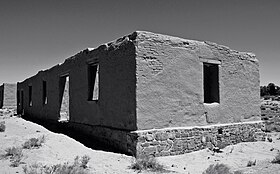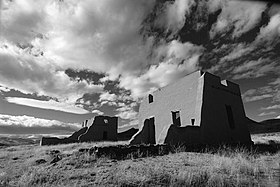Fort Churchill (Nevada)
| Fort Churchill State Historic Park | |
| Nevada State Park | |
| Country | |
|---|---|
| State | |
| County | Lyon |
| Nearest town | Silver Springs |
| Elevation | 4,255 ft (1,297 m) |
| Coordinates | 39°17′33″N 119°16′18″W / 39.29250°N 119.27167°WCoordinates: 39°17′33″N 119°16′18″W / 39.29250°N 119.27167°W |
| Area | 3,943.99 acres (1,596 ha) |
| Established | 1957 |
| Management | Nevada Division of State Parks |
| Website: Fort Churchill State Historic Park | |
|
Fort Churchill
|
|

Ruins at Fort Churchill State Historic Park
|
|
| Location | Lyon County, Nevada, USA |
| Nearest city | Silver Springs, Nevada |
| Area | 20 acres (8.1 ha) |
| Built | 1860 |
| Architect | Captain Joseph Stewart, Captain F.F. Flint |
| NRHP Reference # | 66000456 |
| Significant dates | |
| Added to NRHP | October 15, 1966 |
| Designated NHL | November 5, 1961 |
Fort Churchill State Historic Park is a state park of Nevada, USA, preserving the remains of a United States Army fort and a waystation on the Pony Express and Central Overland Routes dating back to the 1860s. A 1994 addition forms a corridor along the Carson River. The park is in Lyon County south of the town of Silver Springs. Fort Churchill was designated a National Historic Landmark in 1961. The site is one end of the historic Fort Churchill and Sand Springs Toll Road. It is located on U.S. Route 95 Alternate, 8 miles (13 km) south of U.S. Route 50.
In 1860 a band of Paiutes and Bannocks attacked Williams Station along the Carson River in retaliation for the kidnap and rape of two young Paiute girls by the proprietors of the station. In retaliation a small group of volunteer soldiers and vigilantes led by Maj. William Ormsby attacked the Native Americans, starting the so-called Pyramid Lake War. Ormsby's force was defeated and in response Colonel John C. Hays and Captain Joseph Stewart led a larger force of volunteers and U.S. Regulars to defeat the Natives at the Second Battle of Pyramid Lake.
Captain Stewart, leading the Regular contingent, afterward established a permanent U.S. Army fort along the Carson River near the location of where the hostilities began at Williams Station. The post was named Fort Churchill for Sylvester Churchill, Inspector General of the U.S. Army. Construction on the fort began on July 20, 1860 and was completed in 1861. Built to provide protection for early settlers and the mail route along the Pony Express, the fort became an important supply depot for the Union Army during the American Civil War. Average strength during this time was 200 soldiers, but the post was abandoned in 1869 shortly after the conclusion of the Civil War. The abandoned buildings were sold at an auction for $750 after the state of Nevada declined to take possession of the property.
...
Wikipedia


